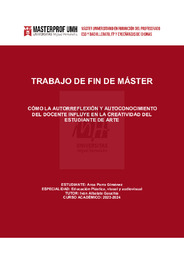Please use this identifier to cite or link to this item:
https://hdl.handle.net/11000/35540Full metadata record
| DC Field | Value | Language |
|---|---|---|
| dc.contributor.advisor | Albalate, Iván | - |
| dc.contributor.author | Parra Giménez, Aroa | - |
| dc.contributor.other | Departamentos de la UMH::Ciencias Sociales y Humanas | es_ES |
| dc.date.accessioned | 2025-02-05T11:09:30Z | - |
| dc.date.available | 2025-02-05T11:09:30Z | - |
| dc.date.created | 2024-09 | - |
| dc.identifier.uri | https://hdl.handle.net/11000/35540 | - |
| dc.description | Especialidad: Educación plástica, visual y audiovisual | es_ES |
| dc.description.abstract | El presente trabajo de investigación se centra en explorar la relación entre la autorreflexión, el autoconocimiento y la creatividad en el ámbito de la docencia en Artes Plásticas. A través de una revisión exhaustiva de la literatura, se ha construido un marco teórico sólido que sustenta la hipótesis central de que la capacidad de los docentes para mirar hacia adentro y comprender sus propias prácticas es un factor determinante para fomentar la creatividad en el aula. También se ha investigado sobre la existencia de un consenso en que las personas creativas tienen los rasgos más expresivos. Estos rasgos latentes incluyen la resiliencia ante la adversidad, la autosuficiencia y la imaginación. Además, es importante mejorar la motivación intrínseca, pero no olvidar la motivación extrínseca, que conviene tener cuidado porque es un motivo externo.Una parte importante del cambio en la creatividad es que el docente se vuelve partícipe, tiene habilidades propias y fortalece su trabajo con herramientas y procesos que fomentan la creatividad de sus alumnos a través de un ambiente sencillo. Uno de muchos de esos ambientes creativos son los FabLabs en los que el alumno encuentra un lugar para desarrollar su creatividad dentro de una comunidad en la que todos se transforman en iguales. | es_ES |
| dc.description.abstract | The present research focuses on exploring the relationship between self-reflection, self-knowledge and creativity in the field of visual arts teaching. Through a comprehensive review of the literature, a solid theoretical framework has been constructed to support the central hypothesis that teachers' ability to look inward and understand their own practices is a determining factor in fostering creativity in the classroom. There has also been research on the existence of a consensus that creative people have the most expressive traits. These latent traits include resilience in the face of adversity, self-reliance, and imagination. In addition, it is important to improve intrinsic motivation, but not to forget extrinsic motivation, which is an external motive. An important part of the change in creativity is that the teacher becomes involved, has skills of his own, and strengthens his work with tools and processes that foster creativity in his students through a simple environment. One of many of these creative environments are the FabLabs where students find a place to develop their creativity. | es_ES |
| dc.format | application/pdf | es_ES |
| dc.format.extent | 15 | es_ES |
| dc.language.iso | spa | es_ES |
| dc.publisher | Universidad Miguel Hernández de Elche | es_ES |
| dc.rights | info:eu-repo/semantics/openAccess | es_ES |
| dc.rights.uri | http://creativecommons.org/licenses/by-nc-nd/4.0/ | * |
| dc.subject | Autorreflexión | es_ES |
| dc.subject | Educación artística | es_ES |
| dc.subject | Desarrollo profesional docente | es_ES |
| dc.title | Cómo la autorreflexión y autoconocimiento del docente influye en la creatividad del estudiante de arte | es_ES |
| dc.type | info:eu-repo/semantics/masterThesis | es_ES |

View/Open:
TFM PARRA GIMENEZ, AROA.pdf
1,75 MB
Adobe PDF
Share:
.png)
